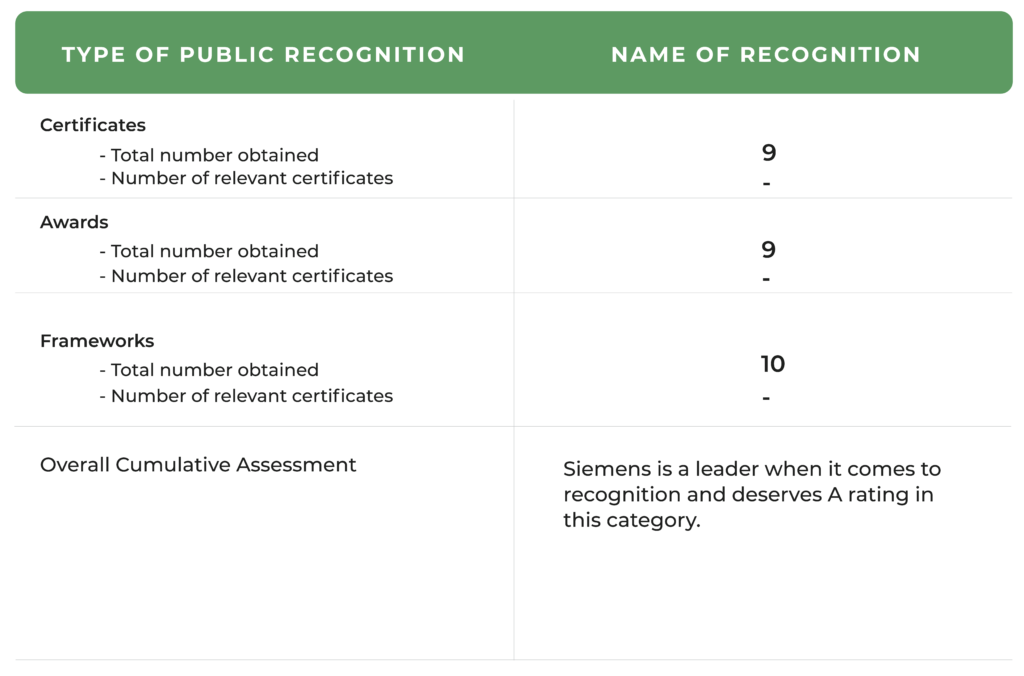
RATING

Outlook
Neutral
SECTOR
Retail Sale Of Electrical Household Appliances, Furniture, Lighting Equipment And Other Household Articles In Specialized Stores
Chief Sustainability Officer
T: N/A
E-mail: N/A
Stock Exchange and Ticker
ETR: SIE
Website
Contact
T: +49 (89) 3803 5491, +49 (69) 797 932850 (sustainability)
E.mail: contact@siemens.com
Listing
- #156 America’s Best Large Employers (2023)
- #365 World’s Top Female-Friendly Companies (2022)
- #245 Mexico’s Best Employers (2022)
- #38 World’s Best Employers (2022)
- America’s Best Employers By State (2022)
- #344 Best Employers for Women (2022)
- #278 Best Employers for New Grads (2022)
- #77 Global 2000 (2022)
- #455 Best Employers for Diversity (2022)
- #187 Canada’s Best Employers (2022)
- #114 Best Employers for Veterans (2021)
- #214 America’s Best Employers (2021)
Awards
- AA rating in MSCI for five years
- Prime status in ESG Corporate Ratings since 2016
- 28.4 points in sustainalytics, 5th in their industry with strong management of ESG risks
- A- rating in CDP, over 10 years at leadership level (A/A-) in Climate Change
- 81 points in Dow Jones Sustainability Indices, #1 in their industry for more than 20 years in the World Index (top 10%)
- Part of the FTSE4Good Index family
- 61 points in ecovadis, silver recognition level and as such within the leading companies in their industry (top 25%)
- 57 points in Vigeo Eiris, constituent of the VigeoEiris EUROZONE 120 index since 2020
- Nuremberg Chamber of Industry and Commerce for Middle Franconia awarded its “Sustainable Business Parks and Commercial Buildings” award to the Siemens Erlangen Campus.
- Forbes Magazine’s Best Employers for Women award
- 100% rating from the Disability Equality Index, in USA
- Human Rights Campaign Foundation – Mejores Lugares Para Trabajar por Equidad LGBT award, in Mexico
Revenue
$68.69B
Market Capitalisation
$80.017B
Employees
303,000
Content source
Siemens Sustainability Report
Evaluation of Siemens
Siemens has set the ambitious target to become carbon neutral by 2030, which they are currently on track to achieve. The company is transparent about their targets and progress. They have also clearly mentioned the SDGs that they focus on. Siemens has a leading amount of notable certificates, standards and frameworks. It also have various sustainability awards and ratings to support their claim. The company seems to be on the right track to achieve their goals.
On the other hand, climate activists pointed out the company’s involvement in Australia’s controversial Adani Carmichael coal mine, which they say runs against the Siemens’s plans to go carbon neutral by 2030. Despite the controversy the company also strike partnerships to improve their sustainability contribution and initiatives. Hence the company can be rated as B.
Sustainability Scorecard
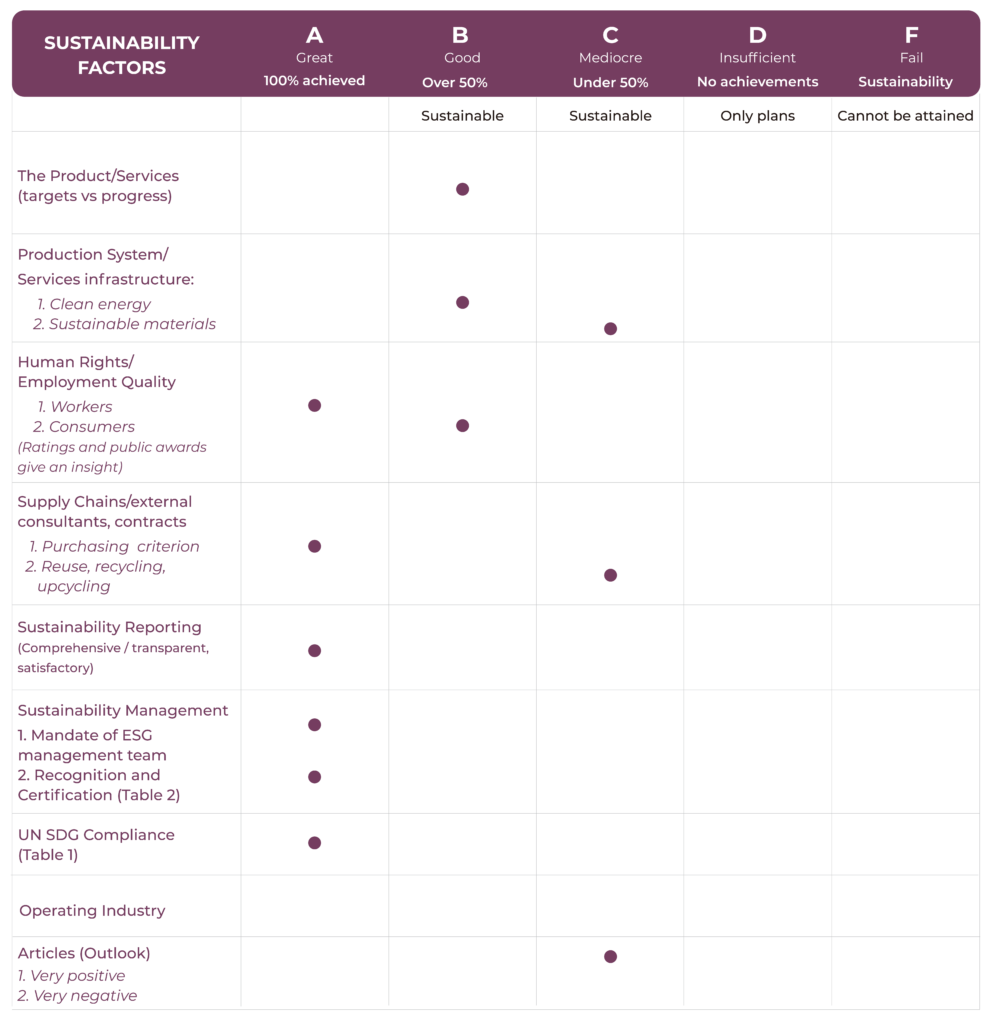
Siemens Company Activity
Siemens is a technology company that focuses on industry, infrastructure, transport, and healthcare. From more resource-efficient factories, resilient supply chains, and smarter buildings and grids, to cleaner and more comfortable transportation as well as advanced healthcare, Siemens claims to “create technology with purpose adding real value for customers” (Siemens, 2021). By combining the material and the digital worlds, they empower their customers to transform their industries and markets, helping them to transform, speed up, and automate the everyday life for billions of people.
Siemens Sustainability Activity - As per company declarations
Siemens take their ESG commitment to the next level with their DEGREE framework. It constitutes a 360-degree approach for all stakeholders – their customers, suppliers, investors, people, the societies they serve, and our planet. In addressing the three aspects of ESG, Siemens are building a better future that helps them stay within the planetary boundaries, helps them foster a culture of trust, empowerment and growth, supports inclusive economic opportunities, and ensures their people and businesses remain resilient and relevant for whatever the future holds.
Siemens’ sustainability indicators include:
- Their Degree framework that sets clear and measurable ambitions
- Their environmental conservation of nature and resources
- Their social contribution to people and society
- Their governance of responsible business practices
Certificate & Labels, Standards and Frameworks
- Global Reporting Initiative (GRI)
- Task Force on Climate-Related Financial Disclosures (TCFD)
- Carbon Disclosure Project (CDP)
- Sustainability Accounting Standards Board (SASB)
- UN Principles for Responsible Investment (PRI)
- World Business Council for Sustainable Development (WBCSD)
- Organization for Economic Co-operation and Development (OECD)
- World Economic Forum (WEF)
- United Nations Global Compact (UNGC)
- United Nations Framework Convention on Climate Change (UNFCCC)
- LEED
- ISO 14001
- ISO 50001.
- ISO 14040
- ISO 14044
- ISO 45001
- ISO 31000
- IEC 62430
- IEC 62474
Siemens in the news: Press Reviews and Social Media
Environmental activists protest against Siemens for taking up a controversial coal mine project in Australia. Siemens decided to provide rail infrastructure for the Carmichael mine in Queensland.
Siemens faced renewed pressure from protestors in their deal with Adani Enterprises on the Charmichael mine. Adani Enterprises had breached some rules and despite the protests, called on Siemens to cancel the contract, the company decides to go ahead with it.
Siemens has taken first place in Dow Jones Sustainability Index, that compliments the company’s sustainability efforts.
Siemens’ partnership with SGS to provide sustainability consulting to companies in Southeast Asia.
Highlights from Siemens Sustainability Report
Achievements
- Leading amount of certifications, awards and frameworks
- Siemens’ suppliers are committed to their Suplier Code of Conduct, to make their supply chain ESG-secured
- Thorough reporting (GRI framework includes SDG compliance)
Weaknesses and Setbacks
- No significant weaknesses or setbacks
Targets vs Progress Reported
| Target | Results reported |
|---|---|
| By joining the Science Based Targets Initiative, Siemens has pledged to reduce emissions from its own operations (Scope 1 and 2) by 50% by the year 2030 and its Scope 3 emissions (upstream and downstream) by 15% compared to 2019 | - Siemens reduced the carbon footprint of their own operations by 54% between 2014 and 2020 (as reported last year, including Siemens Energy), thus achieving their intermediate target last year |
| Siemens has pledged to convert their electricity consumption completely to electricity from renewable sources by the year 2030 at the latest, by joining the RE100 initiative | - 78% in 2021 - Siemens follow the purchasing guidelines of the WWF’s “Next Generation Green Electricity” initiative, in purchasing green electricity |
| Siemens committed to the EV100 initiative and aims to convert their motor vehicle fleet completely to electric vehicles by the year 2030 | - Siemens has increased the number of exclusively electric vehicles to 656 and the number of hybrid vehicles to 2,719. Thus, currently around 8% of their vehicles are pure electric vehicles or at least hybrid vehicles |
| Siemens has a membership in EP100 and targets to only own or lease buildings with no net CO2 emissions by the year 2030 | - With regard to their building emissions, 32 Siemens locations have no net CO2 emissions during regular operations |
| Siemens (excluding SHS) aims to reduce their supply chain emissions by 20% by the year 2030 and eliminate them completely by the year 2050 | - In 2021 the supply chain emissions for the Siemens DEGREE ambition (Siemens without SHS) were reduced by 0.6% to 8,048 kt CO2e since – for the first time – they included their suppliers’ CO2 reductions which they (suppliers) already had executed. Taking the 1.5% increase of their Procurement Volume into account, the CO2 emissions were reduced by more than 2% |
| Siemens’ ambition is to apply the extended “Robust Eco Design” approach to all products, services, and solutions by the year 2030 in order to increase the number of lifecycle assessments and environmental product declarations, raise the proportion of secondary materials, and improve recyclability | - In 2021, Siemens’ share of revenues generated on relevant product families that meet the criteria of “Robust Eco Design” was 55% and the “Robust Eco Design” (without SHS revenues and internal services such as real estate) implementation degree was 26% |
| Siemens targets to achieve circularity through waste-to-landfill reduction of 50% by 2025 and toward zero landfill waste by 2030 Siemens aims to decouple natural resource by increasing the purchase of secondary materials for metals and resins |
- Siemens’ year-on-year, nonhazardous waste decreased by 9%. The volume of hazardous waste decreased by 36% compared to the previous year - Construction waste decreased 76% over the same period - The amount of materials recycled from waste as a percentage of total waste came to 83% for Siemens without SHS |
| Siemens Aims to have 30% female share in top management by 2025 | - In 2021, the percentage of women in the workforce at Siemens is at 27% |
| By 2025; - Double digital learning hours - Maintain access to their employee assistance program: maintain high level and expand globally to 100% Siemens aims for 30% - Improvement in Siemens’ globally aggregated Lost Time Injury Frequency Rate (LTIFR) |
- On average, each employee spent about 22 hours in training during the fiscal year. In terms of the DEGREE ambitions, excluding Siemens Healthineers, each employee completed about 17 hours of digital learning - As an integral part of Siemens’ psychosocial risk management, the Employee Assistance Programs (EAPs) help everyone anonymously to identify and to cope with psychosocial personal stressors. In 2021, 87% of their colleagues had access to these programs - Siemens has achieved 13% reduction in accident rate (LTIFR) compared to previous year |
UN SDGs Compliance Analysis
Progress made toward SDG targets
As reported by Siemens
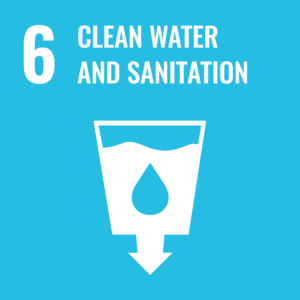
- Siemens analyzed their environmentally relevant locations using the Aqueduct Water Risk Atlas from the World Resources Institute (WRI). With the aid of additional internal analytical systems, Siemens assesses the risks that result on the local level from their sites’ activities and sets them in relation to regional water risks. Locations found to have a high risk in this assessment must set targets to reduce it. In fiscal 2021, 84% of their locations had implemented this water strategy.
- Siemens’ total water consumption decreased 2% from the previous year and is now 15.05 million m3. The largest share of their water consumption is for cooling processes. These processes leave the water’s chemical quality largely unchanged, so that the water can be returned directly to the receiving water body or groundwater.
- Siemens’ total volume of wastewater, excluding chemically unchanged cooling water, came to 4.6 million m3 in fiscal 2021. This is equivalent to a decrease of 9.6% from fiscal 2020. Most of the wastewater, excluding chemically unchanged cooling water, is sewage. The reduction in sewage wastewater can be partially attributed to the sale of gear manufacturer Flender.
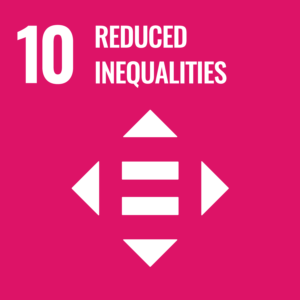
- Siemens supports the UN initiative for global LGBTIQ* Standards of Conduct for Business. Many locations fly rainbow flags, especially in the week before Christopher Street Day.
- On top of that, since 2018 every Siemens social media channel has been rainbow-colored throughout Pride Month. Siemens also provide ways for their LGBTIQ* people to network with each other around the world. Just one example is Pride@Siemens, a network for their people who identify as lesbian, gay, bisexual, transsexual, or intersex, and for their allies.
- Siemens aims to keep expanding gender equality. Their commitment to advancing women at all levels of the company is not limited to complying with statutory or regulatory requirements. In 2021, the percentage of women in the workforce at Siemens is at 27%.
- Siemens also have women networks around the world like Leading Women in Industry (LWI), Global Leadership of Women@Technology & Innovation (GLOW@TI), and Grow2Glow.
- The in-house LWI network is committed to helping place women in more management positions. Siemens advance this mission with strategic fields of action such as flexible working hours, mobile working, and individual career development. GLOW@TI is an in-house network for women with a background in science aims to promote careers for women. Finally, Grow2Glow network provides business coaching for women as a way of elping them realize their full potential.
- In 2021 Siemens also joined the Valuable 500 – an initiative launched by the World Business Forum to place the concerns of persons with disabilities on companies’ management agendas.
- The global Siemens share program, which has been offered annually since 2008, is one of the largest employee share programs in the world. More than 100,000 employees invested in their company in 2021, which means that almost 45% of all eligible employees participated. In addition, Siemens AG distributed around 490,000 free bonus shares to employees in the past fiscal year as part of the global share program. Siemens Healthineers has its own share program that it offers to its employees.
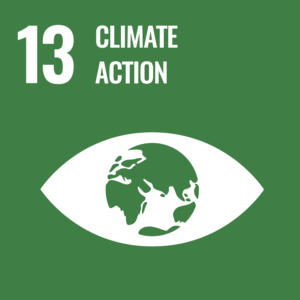
- The revenues generated on the Siemens Environmental Portfolio amounted to €19.1 billion in the past fiscal year. Thus, their Environmental Portfolio accounted for 31% of their total revenues.
- In addition, Siemens’ newly installed Environmental Portfolio elements helped their customers reduce their CO2 emissions by another 8.4 million metric tons in fiscal 2021.
- Including all the Environmental Portfolio elements, Siemens helped their customers reduce their CO2 emissions by 87.5 million metric tons in fiscal 2021. Their CO2 emissions portfolio adjusted value in fiscal 2020 was 80.4 million metric ton. Thus it shows an increase in their reductions at customer level
Sustainability Certificates, Awards and Listings
